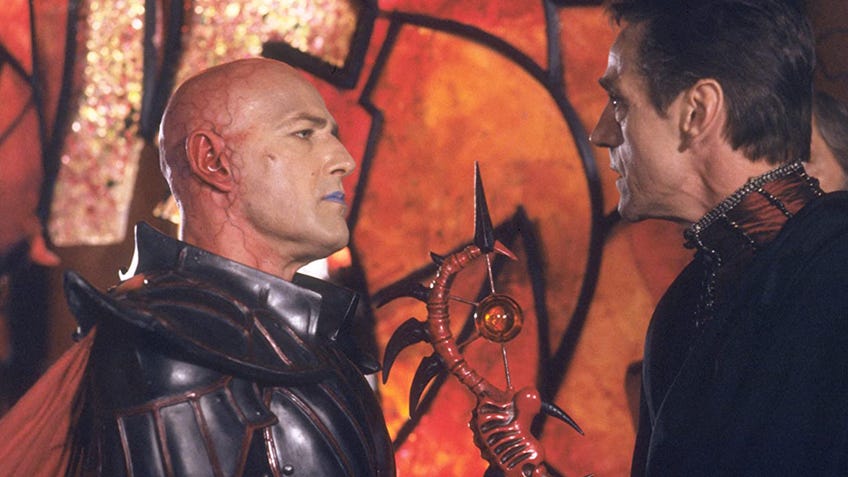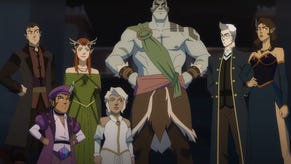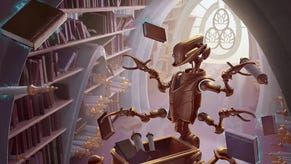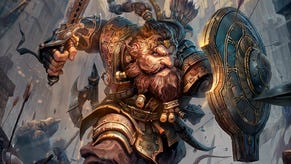The Dungeons & Dragons movie at 20: How the RPG’s first big-screen blockbuster suffered a critical fail
A D&D film was promised to rival Star Wars, but its cinematic debut ended up a box-office bomb. What happened?
One day in 1990, a phone rang at the offices of TSR. On the other end of the line was a 19-year-old Canadian kid named Courtney Solomon. He was by now familiar to some of the staff at the company behind Dungeons & Dragons, having struck up a rapport three months earlier when he first called and told them, untruthfully, that he was working on a school economics project. Today, however, the kid came clean: were the rights available to turn D&D into a movie, he inquired. Because he wanted to make it.
Solomon appeared pretty much out of nowhere. His mother was a freelance production coordinator for movies and TV shows, and he spent his formative years on sets in their hometown of Toronto, helping her out and getting hands-on experience in a variety of production roles. Weaned on the fantastical cinematic adventures of Steven Spielberg and George Lucas, he dreamed of bringing new worlds to life on the big screen. So he decided to dive straight into a film-making career with something truly ambitious.
“I used to play Dungeons & Dragons and couldn’t understand why there had never been a movie,” he told Cinefantastique magazine in 2000. “Just talking to other game players, I knew everybody was waiting for one.”
Astonishingly, through sheer grit, determination, charm and chutzpah, Solomon talked TSR into selling him the rights, pitching them a vision of a trilogy that could be the new Star Wars, only with battling dragons instead of X-Wings and TIE Fighters.
After almost a decade of wranglings, rewrites and setbacks, he ended up directing the first-ever Dungeons & Dragons movie himself: one of the biggest-ever independent films, with a cast that included American Beauty star Thora Birch and Oscar-winning actor Jeremy Irons. It was, on the face of it, a stupendous achievement. A critical hit. Except, well, things didn’t really work out that way.

Solomon’s initial question as to why there had never been a Dungeons & Dragons movie was a good one. By the time he pitched TSR, the company had sold more than 30 million D&D-inspired novels, including Margaret Weis and Tracy Hickman’s epic Dragonlance saga and R.A. Salvatore’s Icewind Dale trilogy. There had also been a mildly embarrassing three-season kids’ TV show, which memorably hurled a group of children into a D&D world via a malfunctioning magical theme-park ride. And the popularity of the game had encouraged a surge in fantasy cinema, leading to the mixed-results likes of Dragonslayer, Conan the Barbarian, Legend and, produced by George Lucas himself, Willow. But there had never been an actual D&D movie. Not for want of trying.
I couldn’t understand why there had never been a movie. Just talking to other game players, I knew everybody was waiting for one.
In March 1983, D&D co-creator and TSR president Gary Gygax moved to Hollywood to start up Dungeons & Dragons Entertainment Corp. His primary aim was to get D&D on cinema screens, believing, as Solomon did, that it had tarrasque-sized blockbuster potential. “I promise you all that if the D&D film isn’t of the quality of Star Wars and Raiders of the Lost Ark,” Gygax wrote in the July 1982 edition of Dragon magazine, “I will not only blast it [...] but I will apologise to you as well. [...] Give us a chance to prove that the genre can be good!”
Gygax rented the Beverly Hills estate once owned by Golden Age director King Vidor and quickly settled into the Hollywood high-life, holding epic revels - including one to which he invited all the contestants of the Miss Beverly Hills International Beauty Pageant - and developing a cocaine habit.

But he wasn’t just partying hard. Gygax took meetings with studio bosses, developed a screenplay with seasoned writer James Goldman (The Lion in Winter, Robin and Marian), hooked the interest of director John Boorman - who’d recently made Arthurian epic Excalibur - and even had lunch with Citizen Kane legend Orson Welles to discuss the role of “a villainous mage”.
However, revelations of financial mismanagement by TSR CEO Kevin Blume and an ensuing power struggle for the company left all those big plans in limbo. Gygax’s Tinseltown exploits helped him find TSR a new manager, Lorraine Dille Williams (inheritor of the Buck Rogers licence), but he had to ditch his movie-making ambitions.
Permanently, it turned out: after a bitter rift between Williams and Gygax, the founding father of roleplaying games was forced out of his own company in October 1985.
Which left the way clear for an unknown teenager to call out of the blue five years later and embark on his own attempt to make D&D: The Movie, like a Level 1 character heading off on some epic quest.
What a long, twisting and frustrating quest that turned out to be. Between 1990 and 1999, every time Solomon seemed close to making a deal with someone, it fell apart. He drew the interest of Godfather director Francis Ford Coppola, action helmer Renny Harlin and even came close to bringing on board no less an impressive figure than James Cameron.
“I promise you all that if the D&D film isn’t of the quality of Star Wars and Raiders of the Lost Ark,” Gygax wrote. “I will not only blast it [...] but I will apologise to you as well.”
But each attempt was like a tottering Jenga tower of promises. All it took was for one studio, producer or investor to pull out - as was the case with the Cameron-involved incarnation - and the whole thing came tumbling down. More often than not, Solomon said, this was down to the fantasy genre being “such a mess at the time”.
TSR didn’t help matters. In a 2006 interview with movie news website CHUD, Solomon recalls a lunch with Cameron and Lorraine Williams, in which the TSR boss folded her arms, eyeballed the director of The Terminator, Aliens and The Abyss, and said, “What are your qualifications to direct this film?” (It should be noted that Cameron never said he’d direct; he was willing to take a hands-on producing role.)

Then, in 1997, with TSR riven by debt and flailing in a bold new world of collectible card games, Williams sold the company to Magic: The Gathering publisher Wizards of the Coast.
Wizards seemed less than enthusiastic about Solomon making the film, despite him bringing on Hollywood big gun Joel Silver - the producer behind the Die Hard, Lethal Weapon and Matrix series, among others - as executive producer. They even filed a lawsuit against Solomon’s company, Sweetpea Entertainment, when he stepped up as director - a move, he claimed, he was forced into by his impatient investors - to make the film as a $3.5 million, straight-to-video quickie. They settled out of court, Solomon told CHUD, on condition that he just get the movie done as a theatrical release, “within a certain amount of months, or we’d lose our rights entirely”.
In the end, his original $100 million vision became a $36 million compromise shot in the Czech Republic, with Solomon directing from an earlier, weaker draft of the script he claims he “got stuck with” because, he believed, Wizards “wanted it to fail”.

And fail it did. On release in December 2000, the Dungeons & Dragons movie grossed only $33 million worldwide and was savaged by critics. On review-aggregating site Rotten Tomatoes it has a score of only 10%. The Hollywood Reporter described it as a “painfully derivative clunker,” while Variety insisted that “the average episode of Xena or Hercules offers a more compelling and imaginative photoplay”.
It seemed better to just do a generic campaign that had all the rules and the creatures and the spells you would use in any campaign setting.
Solomon strived hard during the shoot, but all his bone-deep passion as a soundstage-raised young film-maker and D&D-playing fan was insufficient to overcome both his inexperience and budgetary restrictions. The film’s red and gold CG dragons look half-rendered, and the sets feel cheap and fake - including, ironically, some impressive Prague-based locations, including the Sedlec Ossuary.
His inventive casting, meanwhile, failed to conjure any on-screen chemistry. The double act of Lois & Clark’s Justin Whalin and Marlon “Scary Movie” Wayans as buddy thieves Ridley and Snails amounts to little more than a series of patience-testing eye-rolls and screeches. Birch’s weirdly democracy-loving Empress is balsa-wood stiff, and Jeremy Irons’ evil wizard Profion appears to be in a wild-eyebrowed scenery-chewing contest with his blue-lipped henchlump Damodar, essayed by ’90s rent-a-baddie Bruce Payne. Audience-winky cameos from The Crystal Maze presenter Richard O’Brien as a smirking maze-master and one-time Time Lord Tom Baker as a sincere elven healer don’t help matters.
The film’s greatest weakest is its script, which sets its barely introduced heroes (including Pirates of the Caribbean comic relief Lee Arenberg as a human-sized dwarf who joins the party for no discernible reason) off on a join-the-dots quest for a rod of dragon control, to help counter a grab for power by a bunch of oligarchal mages led by Profion. Along the way, it serves up some unintentionally hilarious dialogue clunkers. “Just like you thieves,” Payne snarls at one point, “always taking things that don’t belong to you.”
However, it’s hard to question the purity of Solomon’s enthusiasm and intentions. He resisted using a hokey device by which real-world players become absorbed, Jumanji-style, into the game world (similar to both the cartoon series and Goldman’s shelved 1983 script), and took the smarter, Star Wars-inspired route of keeping the fantasy setting ‘real’.
Instead of adapting any of the D&D novels or using a popular campaign world, such as Krynn, Eberron or the Forgotten Realms, he wanted the film to channel the RPG itself. So the Empire of Izmer is loosely based on the little-remembered original Basic D&D setting of Mystara. “It seemed better to just do a generic campaign that had all the rules and the creatures and the spells you would use in any campaign setting,” Solomon told IGN Sci-fi in 2000.

Spells such as Hold Person and Fireball feature, while it’s not hard to work out each character’s class. Yet, at the same time, there’s a notable dearth of D&D favourite beasties, with only walk-on/float-on appearances from some orcs and beholders, and a bit-part for a quasit. Fair play to Solomon, though, for throwing all caution to the wind and opening the movie with a dragon in a dungeon. It certainly does what it says on the tin.
Dave Arneson praised Solomon’s movie as “some of the most innovative film-making that has ever been done".
One of D&D’s creators, at least, was a fan. After a preview event at the Los Angeles Comic Book and Science Convention on November 14th 2000, Dave Arneson praised Solomon’s movie as “some of the most innovative film-making that has ever been done,” and insisted that “the viewer, whether he is someone totally unfamiliar with D&D or a veteran from the days of Blackmoor, or more, will absolutely NOT be disappointed!” Yes. Well.

As with many box-office disappointments, Dungeons & Dragons eventually turned a profit thanks to DVD sales and rentals. No doubt buoyed by the reinvigoration of fantasy through the immense success of Harry Potter and The Lord of the Rings, two movie franchises which launched less than a year later, it even received a pair of straight-to-DVD sequels in 2005 and 2012.
Nevertheless, it would take Solomon 11 years to recover and return with a second movie, solid horror picture An American Haunting. “Hollywood’s not a very forgiving town is it?” he told CHUD on its release. “You do a crappy movie and they’re not too interested.” Today, he still works in showbusiness, and is currently busy developing a TV adaptation of cult cartoon strip The Furry Freak Brothers.
It remains unclear how involved Solomon is in the upcoming 2022 Dungeons & Dragons movie, directed by Game Night’s John Francis Daley and Jonathan Levine. He is listed on the Internet Movie Database as one of the film’s six producers, but that’s no indication of his level of creative involvement.
One thing’s for certain: the next D&D movie is going to be a very different beast - and the story of its creation will be nowhere near as wild.










